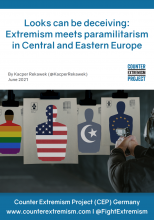
Central-Eastern Europe (CEE) host a variety of paramilitary organisations. Some of these consider themselves anti-systemic, i.e. anti-democratic, anti-liberal, nativist, authoritarian and also, at times, pan-Slavic or pro-Russian (apart from the Ukrainian case).
They are sometimes an integral part of the far-right political scene (Hungary, Ukraine) or exist largely outside it (Czech Republic, Slovakia) but their members share a lot of views with e.g. the broader Western European far-right or its most aggressive and militant component, the extreme right-wing (XRW).
CEE paramilitary groups are transnationally connected but their connections are directed eastward (i.e. with Russia or Russian groups or individuals). At the same time, the region’s far-right radicals and right-wing extremist would be more, albeit not exclusively, oriented towards the West – as is demonstrated during trademark “nationalist” events in CEE – for example, the Independence Day March in Poland or the Day of Honour in Hungary, which attract a wide range of right-wing extremists from Europe and the United States.
The CEE far-right radicals and right-wing extremists are often perceived as militant, but their organisations are not paramilitary in nature (apart from the Ukrainian case). Their disconnect from the local paramilitary scenes is not the source of their international appeal. The pull factor of these networks and their inspiration for networks in the West mostly stems from the perception among right-wing extremists in the West that CEE is a homogenous, traditional, Christian, “white” region of Europe in which right-wing extremists are allegedly free to “be themselves.”
At the same time, some Western right-wing extremists have demonstrated that they seek opportunities to gain paramilitary experience and training in the CEE. Such training, however, rarely is conducted with likeminded individuals from the CEE or the region’s paramilitaries. It is mostly acquired individually and in a commercial fashion at one of the region’s many shooting ranges, clubs or academies. These at times offer sophisticated training options for both local and foreign clients, without stringent know your customer protocols.
Two potential developments would constitute a particular worrying threat for policymakers and security authorities:
- If the Western right-wing extremists were to connect with some of the region’s panSlavic paramilitaries (e.g. via joint Russian acquaintances). The Czech case of the so-called “Czechoslovak Soldiers” described in this report is the indicative for such a potential development.
- If the Western right-wing extremists make more concerted use of the sprawling paramilitary infrastructure in Ukraine which, despite external concerns, has so far been geared towards local customers, including members of local right-wing extremist organisations, some with a record of (para)military activities.
Consequently, the policy recommendations of this report are aimed towards mitigating these two potential threats. They advise a focus and further analysis of the CEE’s pan-Slavic and non-governmental paramilitaries and their links to Moscow, advise involving Ukrainian authorities in collecting information about foreigners seeking training there, similar to the already ongoing cooperation between the Ukraine and the United States, and explore the possibility to restrict travel of high-risk violent right-wing extremist individuals in order to bar them from accessing the commercial training infrastructure. Finally, the report suggests exploring the existing Czech legal arrangements that bars paramilitary training for civilians as a potential blueprint for similar legal mechanisms.